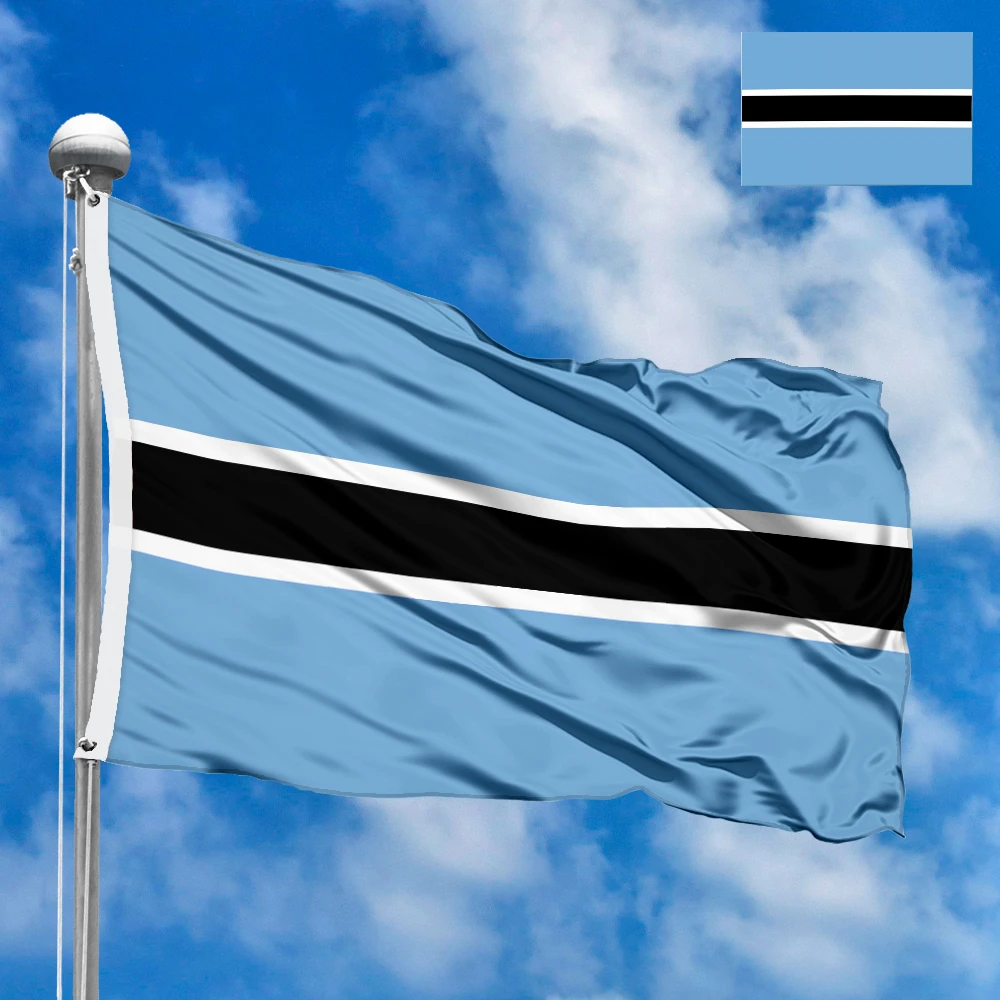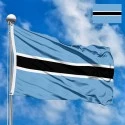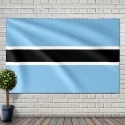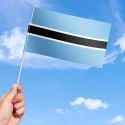Flag of Botswana
- Flag Type: State
- Proportions (official): 2:3
- Official name: Republic of Botswana
- Local name: Botswana
- Sovereignty (year): YES (1966)
- Member of Organizations: UN, Commonwealth of Nations, African Union
- Country code, territory: BW, BWA, 072
- Capital: Gaborone
- Large cities: Francistown, Molepolole, Serowe
- Population: ~2,700,000 (2024, UN)
- Religions: Christianity ~79%, Badimo ~6%
- Area (km²): 581 730
- Highest point: Tsodilo Hills (1,489 m)
- Lowest point: Confluence of Limpopo and Shashe Rivers (513 m)
- Currency: Botswana pula (BWP, P)
- Languages: English, Setswana
- Dialing code: +267
- National domain: .bw
Flag Information
General information
Demography and Culture
Economy and communications
- All Flags
- Flags of Countries by Continent
-
Flags of Organizations
- Flags of UN countries
- Flags of the European Union countries
- Flags of NATO countries
- Flags of the countries of the Organization of Islamic Cooperation
- Flags of the countries of the Organization of American States
- Flags of the Arab League countries
- Flags of the African Union countries
- Flags of the countries of the Union of South American Nations
- Flags of the Commonwealth of Nations
- Flags of the countries of the Secretariat of the Pacific Community
- Flags of the Nordic Council countries
- Flags of the Caribbean Community
- Flags of the countries of the Association of Southeast Asian Nations
- Flags of the East African Community
- Flags of the countries of the Organization of Turkic States
- LGBT Community Flags
- Historical Flags
- Ethnic Flags
- Flags of the USA (states)
Description
The national flag of Botswana is a vibrant and deeply symbolic emblem that encapsulates the aspirations, values, and natural characteristics of this remarkable Southern African nation. Adopted on September 30, 1966, the very day Botswana gained its independence from British rule, the flag serves as a powerful visual testament to the country's peaceful transition to self-governance, its commitment to democracy, and its unique cultural identity. It is a harmonious blend of colors and design elements, each carrying profound meaning for the Batswana people and representing a collective vision for their future.
Design and Symbolism: A Tapestry of Peace, Water, and Harmony
The flag of Botswana features a distinctive and easily recognizable design: a light blue field, with a horizontal black stripe, fimbriated in white, running across its center. The simplicity of its design belies the depth of its symbolism, reflecting core principles that have guided Botswana's journey as an independent nation:
-
The Light Blue Field: Water, Life, and Prosperity. The dominant light blue color that forms the background of the flag is arguably its most significant symbolic element. It represents water, specifically the life-giving rain, which is a precious and often scarce resource in Botswana's largely arid environment. The national motto, "Pula", which literally means "rain" in Setswana, also serves as the national greeting and signifies the vital importance of water for the country's prosperity and survival. This blue symbolizes the nation's reliance on rain for its agriculture, livestock, and overall well-being, embodying hope for abundance and a prosperous future. It also speaks to the importance of the Okavango Delta, a vast inland delta that is a lifeline for much of Botswana's wildlife and a significant natural wonder. Thus, the blue evokes life, vitality, and the natural resources that sustain the Batswana people.
-
The Black Stripe: The People and Racial Harmony. The black stripe positioned horizontally across the center of the flag represents the majority black population of Botswana. It is a direct acknowledgment of the people who form the foundation of the nation. Importantly, this black stripe is not meant to signify exclusivity but rather inclusivity. It symbolizes the presence and importance of all racial groups living within Botswana, emphasizing the nation's commitment to racial harmony and unity. Botswana has a history of peaceful coexistence among its diverse ethnic groups, and the black stripe serves as a visual pledge to maintain this unity and equality for all citizens, regardless of their background. It underscores the nation's dedication to a non-racial society, where every individual contributes to the collective progress.
-
The White Fimbriations: Purity, Peace, and Inclusivity. The two thin white stripes that border the central black stripe, known as fimbriations, are crucial to the flag's symbolism. The white color represents peace, purity, and honesty. These qualities are central to Botswana's democratic principles and its foreign policy of non-alignment and peaceful diplomacy. Furthermore, the white stripes, flanking the black, emphasize the multiracial nature of Botswana's society. They symbolize the equal importance and inclusion of all non-black citizens, highlighting the harmonious co-existence of various ethnic and racial groups within the nation. The white bands, therefore, complete the narrative of racial harmony and unity, symbolizing the shared aspirations and the peaceful interaction between all segments of the population.
Together, the design tells a story of a nation built on the foundation of its people (black), striving for prosperity through its natural resources (blue – water/rain), and committed to peace and unity among all its inhabitants (white). It's a powerful visual declaration of Botswana's values: democracy, peace, dignity, and a shared future for all.
Dimensions and Proportions: A Balanced Canvas of National Values
The official dimensions and proportions of the Flag of Botswana are carefully prescribed to ensure its consistent and dignified appearance across all forms of display. The flag adheres to a width-to-length ratio of 2:3. This specific ratio is a common standard for national flags globally, providing a balanced and aesthetically pleasing rectangular shape. The 2:3 proportion is favored for its versatility, allowing the flag to be easily scaled for various display purposes, from monumental installations to smaller, handheld flags, while maintaining its visual integrity and symbolic clarity.
The central design element, consisting of the black stripe bordered by two white fimbriations, occupies a precise proportion of the flag's vertical dimension. The black stripe itself is one-ninth (1/9) of the flag's total width. Flanking this black stripe, each of the white fimbriations (the thin white lines) measures one-eighteenth (1/18) of the flag's total width. This means that the total width of the black stripe and its two white fimbriations combined accounts for three-ninths (3/9) or one-third (1/3) of the flag's total vertical height.
The remaining two-thirds of the flag's vertical space are equally divided between the upper light blue field and the lower light blue field, each occupying one-third (1/3) of the flag's total width. This meticulous proportional division ensures a balanced distribution of the symbolic colors, emphasizing the centrality of the black and white elements within the overarching blue field.
This precise proportional design is crucial for upholding the flag's dignity and ensuring its accurate representation as a proud national emblem. Whether flying majestically over government buildings, displayed during international diplomatic events, unfurled at sporting competitions, or celebrated in national festivities, the 2:3 ratio, the specific widths of the black and white stripes, and the surrounding blue fields ensure that the flag of Botswana consistently projects a strong, unified, and harmoniously balanced image. This adherence to precise dimensions is vital for conveying its message of peace, water, racial harmony, and national unity to both its citizens and the world.
History and Evolution: A Symbol Born of Peaceful Transition
The history of Botswana's national flag is unique in that it represents a deliberate and peaceful break from colonial rule, unlike many African nations whose flags emerged from more turbulent revolutionary struggles. The flag's creation is intrinsically linked to the country's independence in 1966 and its aspiration to project a distinct, unified, and progressive identity.
-
Pre-Independence (Before 1966): British Protectorate. Before gaining independence, the territory now known as Botswana was a British protectorate called Bechuanaland. During this period, the Union Flag (Union Jack) of the United Kingdom would have been the official flag flown throughout the protectorate. There was no distinct flag representing the indigenous Tswana people or the protectorate as a whole, as it was under direct British administration.
-
The Path to Independence and Flag Design (Early 1960s). As Bechuanaland moved towards self-governance in the early to mid-1960s, the need for a national flag became a priority for the emerging Batswana leadership. Unlike some newly independent African nations that adopted flags with Pan-African colors (red, green, yellow) to signify solidarity with broader liberation movements, Botswana's leaders, particularly its first president Sir Seretse Khama, sought a design that would reflect the country's unique circumstances and values. Their aim was to symbolize a peaceful and inclusive future, rather than a continuation of revolutionary struggle. The design for the flag was chosen through a national competition or deliberation process, with a strong emphasis on colors and symbols that were directly relevant to Botswana's environment, people, and political philosophy.
-
Adoption on Independence Day (September 30, 1966). The current flag of Botswana was officially adopted on September 30, 1966, the very day the country gained full independence from the United Kingdom. This simultaneous adoption of the flag and independence highlighted the flag's role as a symbol of the new sovereign state. The design was a deliberate departure from the British colonial symbols and also from the trend of Pan-African colors, opting instead for a scheme that uniquely represented Botswana's values of peace, water, and racial harmony. The flag's colors were carefully selected to convey these messages:
-
Light Blue: Representing "Pula" (rain) and water, crucial for a semi-arid country.
-
Black: Symbolizing the majority black population.
-
White: Representing racial harmony and the presence of all other races. The white stripes flanking the black were also seen as a direct representation of the zebra, a national animal, further cementing its indigenous relevance, though this is primarily an interpretation rather than an explicit design brief.
-
-
Post-Independence Era (1966-Present): Enduring Symbolism. Since its adoption, the flag of Botswana has remained unchanged. This continuity is a testament to the enduring relevance and universal acceptance of its symbolism among the Batswana people. It has successfully transcended political changes and has become a stable and cherished national icon. The flag continues to embody Botswana's commitment to democratic governance, economic stability, peaceful international relations, and, critically, racial harmony. Its design, rooted in the values that guided the nation's peaceful independence, continues to serve as a powerful reminder of Botswana's unique path and its vision for a prosperous and inclusive future.
In summary, the history of Botswana's flag is one of thoughtful design and peaceful transition, a powerful visual narrative that continues to inspire pride and unity among its citizens.
Regional Context and Southern African Identity: A Beacon of Stability
The flag of Botswana holds a distinct and significant position within the vexillological landscape of Southern Africa, largely due to its unique symbolism, its peaceful origins, and the country's consistent record of democratic stability and good governance in a region often marked by conflict and political upheaval. While many African flags incorporate Pan-African colors (red, yellow/gold, green), Botswana's flag intentionally deviates from this trend, choosing a color scheme that is deeply rooted in its specific national identity and aspirations.
-
Emphasis on Peace and Water, Not Revolution: Unlike the flags of several other Southern African nations that emerged from armed liberation struggles (e.g., South Africa, Zimbabwe, Mozambique, Angola, where red often symbolizes blood shed for freedom), Botswana's flag primarily emphasizes peace (white) and water (blue). This reflects Botswana's remarkably peaceful transition to independence and its enduring commitment to diplomacy and stability. The prominent light blue field and the national motto "Pula" (rain) immediately connect the flag to the country's arid environment and the vital importance of water, setting it apart from flags that focus on historical conflicts or ideological movements.
-
Symbol of Racial Harmony: The black stripe fimbriated in white is a powerful and explicit statement about racial harmony and inclusivity. In a region that has historically grappled with the legacy of apartheid and racial segregation (most notably in South Africa and Namibia), Botswana's flag stands as a beacon of multiracial unity. This strong emphasis on equality among all citizens, regardless of race, is a defining feature of Botswana's national identity and is clearly articulated in its flag, distinguishing it from countries where such harmony has been a more recent and hard-won achievement.
-
Democratic Stability and Good Governance: Botswana has consistently been one of Africa's most stable democracies since independence, characterized by regular elections, respect for the rule of law, and a robust economy. The flag, with its symbolism of peace and unity, represents this stability and the nation's commitment to democratic principles. It projects an image of a well-governed nation that prioritizes the welfare of all its citizens, serving as a model of successful post-colonial development in the region.
-
Departure from Pan-African Colors: While the Pan-African colors are widely used across the continent to signify shared history and solidarity, Botswana's deliberate choice of blue, black, and white underscores its unique path. This decision was not a rejection of Pan-Africanism, but rather an assertion of a distinct national identity rooted in its specific challenges and strengths. It showcases a nation confident enough in its own identity to forge its own visual language, rather than conforming to a broader regional or continental trend.
-
Economic Prudence and Development: Botswana's economic success, largely driven by prudent management of its diamond resources, is implicitly supported by the flag's symbolism of water/prosperity (blue). A stable and unified society, as represented by the flag, creates an environment conducive to economic growth and equitable distribution of wealth, which are goals shared by many in the region.
In essence, the flag of Botswana stands out in Southern Africa as a symbol of peaceful self-determination, racial inclusivity, and unwavering democratic principles. It is a visual representation of a nation that has successfully navigated the complexities of post-colonial development, serving as a consistent example of stability and progress in the region. Its unique design and profound symbolism make it a powerful testament to Botswana's distinct identity and its contributions to the African narrative.
Interesting Facts About The Flag of Botswana:
-
Peaceful Birth: The flag was adopted on September 30, 1966, the very day Botswana gained independence from the United Kingdom, symbolizing a peaceful transition to self-governance rather than a violent struggle.
-
"Pula" is Key: The dominant light blue color represents "Pula," the national motto and the Setswana word for "rain." Rain is incredibly precious in Botswana's arid climate, symbolizing water, life, and prosperity. "Pula" is also the currency of Botswana and a common greeting, underscoring its profound significance.
-
Unique Color Scheme in Africa: Unlike many other African flags that use the Pan-African colors (red, yellow, green) to signify liberation and unity, Botswana's flag deliberately chose blue, black, and white to represent its specific values of peace, water, and racial harmony.
-
Racial Harmony Symbolism: The black stripe represents the majority black population, while the two white fimbriations (thin stripes) symbolize racial harmony and the coexistence of all racial groups within the nation. This is a powerful message, especially in a region that has faced racial tensions.
-
Zebra Interpretation: While not an explicit design brief, the black and white stripes are often interpreted by Batswana to represent the zebra, the national animal of Botswana. The zebra's stripes symbolize the harmonious coexistence of different races working together.
-
Simple Yet Profound: The flag's simple geometric design belies its deep and multifaceted symbolism, making it easily recognizable and meaningful.
-
Unchanged Since Independence: The flag has remained unchanged since its adoption in 1966, reflecting the country's consistent political stability and the enduring relevance of its core values.
-
No Revolutionary Blood: The absence of red in the flag distinguishes it from many other African nations whose flags feature red to symbolize the blood shed during independence struggles. This highlights Botswana's unique path to peaceful self-determination.
-
Democratic Showcase: The flag is frequently seen in international forums, symbolizing Botswana's consistent record as a stable democracy and a model of good governance in Africa.
-
Used in Education: The flag's symbolism is taught to children in schools, instilling a sense of national pride, respect for diversity, and an understanding of the country's founding principles.
Significance for the Inhabitants: A Banner of Peace, Prosperity, and Unity
For the people of Botswana, their national flag is a profound and deeply cherished symbol that encapsulates their nation's peaceful journey to independence, its enduring values of democracy and harmony, and its collective aspirations for a prosperous future. It is a constant visual reminder of their unique identity as Batswana and the principles that guide their daily lives and national development.
The dominant light blue field resonates profoundly with the Batswana people, as it represents "Pula" (rain), a life-giving force in their largely arid land. In a country where rainfall is scarce and essential for agriculture, livestock, and overall well-being, the blue symbolizes hope, life, and prosperity. It evokes the vital connection to nature and the preciousness of water, which is fundamental to their survival and economic development. For every Motswana, the blue is a reminder of the constant hope for good rains and the blessings they bring, fostering a deep appreciation for their natural environment and its role in their livelihoods. It inspires a sense of optimism and resilience in the face of environmental challenges.
The central black stripe holds immense significance for the Batswana people, representing the majority black population and, crucially, the unity and equality of all races within the nation. In a continent with a history of racial tensions and, in some cases, conflict, Botswana’s commitment to racial harmony is a source of immense national pride. The black stripe signifies that all citizens, regardless of their ethnic or racial background, are equally valued and integral to the fabric of the nation. It fosters a sense of shared identity and belonging, emphasizing that the strength of Botswana lies in its diversity and its ability to build a cohesive society where everyone can thrive.
The two thin white fimbriations bordering the black stripe further reinforce this message of inclusivity and peace. White symbolizes purity, peace, and honesty, values that are deeply embedded in Botswana's democratic governance and its peaceful foreign policy. These white stripes, flanking the black, vividly represent the harmonious coexistence of all racial groups within Botswana, including the significant white minority and other ethnic communities. They serve as a constant visual pledge to maintain peace, ensure justice, and promote equality for every individual. For the inhabitants, these white lines embody the aspiration for a nation where dialogue, understanding, and mutual respect prevail over conflict and division.
When the flag is proudly displayed—during national holidays like Independence Day, at schools, on government buildings, during sporting events, or in private homes—it invariably ignites a profound sense of patriotism, unity, and shared destiny among the Batswana people. It serves as a powerful reminder that despite challenges, they are united by a common commitment to peace, democracy, and collective progress. The flag is a cherished emblem that evokes deep pride in their country's peaceful history, its democratic institutions, and its dedication to building a society where water brings life, and all people live together in harmony, embodying the very spirit of "Pula" and the uprightness of the Batswana.
In the demonstration images, full-size flags are shown with proportions of 2:3, and hand-held flags with proportions of 1:2.
Donation
Download
Completely free for commercial and non-commercial use (public domain).
You can freely use them in your news magazines, websites, software, mobile applications.
We appreciate a backlink to https://flagssite.com
Raster files - Flag of Botswana (PNG, JPG)
 Waving flag
Waving flag
- PNG format (transparent background), 72dpi, dimensions in Pixels (px), aspect ratio 3:4.
- 15х20 px
- 30х40 px
- 60х80 px
- 120x160 px
- 240x320 px
 Sizes:
Sizes:
"v15" - image size (by height); if necessary, replace with available: v15, v30, v60, v120, v240.
!!! For resizing, use the Latin (eng) keyboard layout.
<img src="https://flagssite.com/flags/v15/20404.png" alt="Flag of Botswana">
 Round flag
Round flag
- PNG format (transparent background), 72dpi, dimensions in Pixels (px), aspect ratio 1:1.
"d15" - image size (diameter); if necessary, replace with available: d15, d30, d60, d120, d240.
!!! For resizing, use the Latin (eng) keyboard layout.
<img src="https://flagssite.com/flags/d15/20404.png" alt="Flag of Botswana">
 Rectangular flag 2:3
Rectangular flag 2:3
- JPG format, 72dpi, dimensions in Pixels (px), aspect ratio 2:3.
"h30" - image size (by height); if necessary, replace with available: h15, h30, h60, h120, h240, h360, h480.
!!! For resizing, use the Latin (eng) keyboard layout.
<img src="https://flagssite.com/flags/h30/20404.jpg" alt="Flag of Botswana">







 Sizes:
Sizes:
 Sizes:
Sizes: